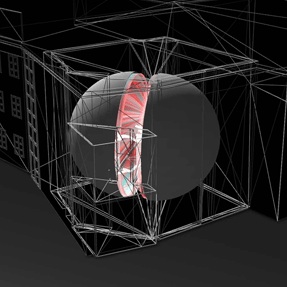I was working on the Allosphere project during my stay at UCSB. Mostly in terms of experimenting with projection warping in a full-dome environment, and with bringing in content, especially through the Soundium platform.
The AlloSphere is a large, immersive, multimedia and multimodal instrument for scientific and artistic exploration being built at UC Santa Barbara. Physically, the AlloSphere is a three-story cubic space housing a large perforated metal sphere that serves as a display surface. A bridge cuts through the center of the sphere from the second floor and comfortably holds up to 25 participants. The first generation AlloSphere instrumentation design includes 14 high-resolution stereo video projectors to light up the complete spherical display surface, 256 speakers distributed outside the surface to provide high quality spatial sound, a suite of sensors and interaction devices to enable rich user interaction with the data and simulations, and the computing infrastructure to enable the high-volume computations necessary to provide a rich visual, aural, and interactive experience for the user. When fully equipped, the AlloSphere will be one of the largest scientific instruments in the world; it will also serve as an ongoing research testbed for several important areas of computing, such as scientific visualization, numerical simulations, large scale sensor networks, high-performance computing, data mining, knowledge discovery, multimedia systems, and human-computer interaction. It will be a unique immersive exploration environment, with a full surrounding sphere of high quality stereo video and spatial sound and user tracking for rich interaction. It will support rich interaction and exploration of a single user, small groups, or small classrooms.
The AlloSphere differs from conventional virtual reality environments, such as a CAVE or a hemispherical immersive theater, by its seamless surround-view capabilities and its focus on multiple sensory modalities and interaction. It enables much higher levels of immersion and user/researcher participation than existing immersive environments. The AlloSphere research landscape comprises two general directions: (1) computing research, which includes audio and visual multimedia visualization, human computer interaction, and computer systems research focused largely on the Allosphere itself – i.e., pushing the state of the art in these areas to create the most advanced and effective immersive visualization environment possible; and (2) applications research, which describes the integration of Allosphere technologies to scientific and engineering problems to produce domain-specific applications for analysis and exploration in areas such as nanotechnology, biochemistry, quantum computing, brain imaging, geoscience, and large scale design. These two types of research activities are different yet tightly coupled, feeding back to one another. Computing research produces and improves the enabling technologies for the applications research, which in turn drive, guide, and re-inform the computing research.
http://www.allosphere.ucsb.edu/
Location: California NanoSystems Institute, University of California, Santa Barbara
Period: 2007 – 2008

